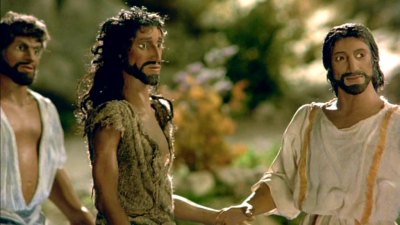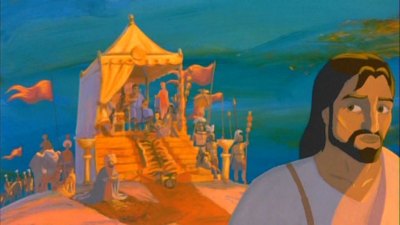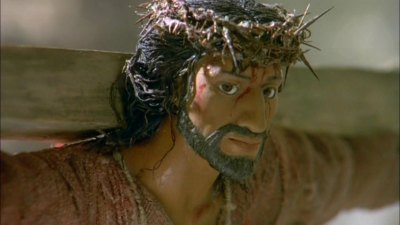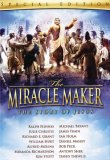| Reviews & Columns |
|
Reviews DVD TV on DVD Blu-ray 4K UHD International DVDs In Theaters Reviews by Studio Video Games Features Collector Series DVDs Easter Egg Database Interviews DVD Talk Radio Feature Articles Columns Anime Talk DVD Savant Horror DVDs The M.O.D. Squad Art House HD Talk Silent DVD
|
DVD Talk Forum |
|
|
| Resources |
|
DVD Price Search Customer Service #'s RCE Info Links |
|
Columns
|
|
|
Miracle Maker: The Story of Jesus - Special Edition, The
Sweet! A Claymation Christ! Having always been a big fan of the claymation process (the surreal adventures of Gumby still rank high among my childhood memories), I was intrigued when I saw The Miracle Maker: The Story of Jesus was animated, in part, using a similar process ("fastflex," a latex covering, was used over the puppets' metal exoskeleton, not the traditional clay or plasticine). I was curious not only to see this new technique, but curious also to see how the claymation process, which usually comes off as humorous and somewhat kitschy due to its predominant use in children's and fantasy-related projects, would meld with a story that so many people view with the utmost solemnity. Would the claymation Christ of The Miracle Maker: The Story of Jesus somehow seem inherently irreverent, when it shared a common visual heritage with the California Raisins?

In an effort to bring a different storytelling angle to this recounting, The Miracle Maker: The Story of Jesus tells the oft-told Easter story of Jesus (Ralph Fiennes) meeting his preordained fate and resurrection, through the framing story of Tamar, the young girl who is deathly ill until her father, Jairus (William Hurt) seeks Jesus' help. An effort has been made in the script to present the story in the plainest of terms, with characters speaking in unadulterated English, with little or no flowery prose associated with most religious epics. Realism seems to be goal of the film, with the claymation figures modeled as closely as possible on the actual human form, and their dialogue written in an easy and accessible style.
On the bonus behind-the-scenes featurette, The Making of The Miracle Maker, included on this DVD, everyone involved in the project goes to great lengths to describe the laborious processes involved in making The Miracle Maker: The Story of Jesus as realistic as possible; in particular, they all comment on the models' startlingly life-like appearances. Well, first off; I don't think the models look all that life-like. Far from fooling the viewer, as someone mentioned, these intricate latex models, created and animated by the famed Christmas Films artisans in Russia, look rather like large G.I. Joes, expertly manipulated no doubt, but hardly "startling" in appearance.
And that's not a knock against the latex models, or the artists who created them. If anything, their still-clumsy approximation of realistic human movement is one of the prime pleasures that comes from the claymation animation process: the totally fake, fantasy illusion of "reality." Frankly, a more realistic model process would have been less interesting. We want to see these dolls look like dolls being manipulated, frame by frame. After all, that's the "gee whiz" appeal of the claymation technique in the first place. So that's why I was a little put off by all this justification by the creative talent involved. It's almost as if they're somewhat embarrassed by the supposedly kiddie associations with claymation, and therefore, they feel the need to elevate the process by declaring it as close to life-like as possible.
According to the bonus featurette, this adherence to reality took the form of large animatronic models that were eventually rejected for use in the final film. The Miracle Maker: The Story of Jesus was a five year co-production between Cartwn Cymru animation studios in Wales and Christmas Films studios in Russia (for release on British TV in 2000). Evidently, the English animators were concerned about the articulation of the hard vinyl heads that the Russians were using, and they developed some rather complicated animatronic heads that would be utilized for close-up shots when the characters were to speak. Rejected outright by the Russian animators, a compromise was developed by using interchangeable mouths that could be inserted in the puppets' heads, to simulate speech. I bring this up because again, everyone seems to want this film to be as realistic as possible. That's fine from the standpoint of trying to stretch and grow a particular animation process, but I don't think it enhances or elevates the inherent properties of claymation by making the dolls hyper-realistic, particularly when the final results are, although very impressive, hardly "realistic." As for the religiosity of the piece, the heightened attempts at realism of The Miracle Maker: The Story of Jesus don't translate into a noticeably more moving or instructive film; after all, anybody who ever grew up on Sunday morning reruns of Art Clokey's almost supernaturally crude (in execution), deeply moving Davey and Goliath, knows that low production values don't equate to diminished dramatic results -- and vice versa.

Further complicating the visual style of The Miracle Maker: The Story of Jesus is the film's reliance on traditional cell animation for Jesus's allegories, flashbacks, and some of the more complicated crowd scenes. While the producers state the traditional animation was used to give an added dimension to the visual strategy of The Miracle Maker: The Story of Jesus, I'm sure it didn't hurt that both companies could work on these different animation techniques at the same time, without having to worry if they'd mesh (the film took five years to produce, largely because of the laborious stop-motion claymation process). But that disregard for melding the two techniques into one visual presentation undermines The Miracle Maker: The Story of Jesus. The cell animation is quite impressive in The Miracle Maker: The Story of Jesus, but it always comes as a jarring transition when we go from the claymation scenes to the cell animation, and then back again. The two forms are so different, however, that it always feels like the film is stopping and starting; we never feel these two divergent animation techniques "go together" in the same film. Eventually, after the second or third transition, I started to wish they had stuck to one technique or the other, and filmed the The Miracle Maker: The Story of Jesus in just one process.
Not helping matters of realism in The Miracle Maker: The Story of Jesus are some rather over-emphatic line readings from the all-star cast. Ralph Fiennes, Julie Christie, Richard E. Grant, William Hurt, Alfred Molina, Miranda Richardson, David Thewlis, and Ian Holm are among the better known members of the voice cast, but perhaps Derek Hayes, the co-director and executive producer of The Miracle Maker: The Story of Jesus should have warned the actors that shouting lines would clash with the still-relatively inexpressive faces of the latex models. Fiennes, Grant, and Richardson (particularly campy as "Mad" Mary Magdalene, as she's referred to in the film) are the main culprits here in hamming up the proceedings; in an effort to be commanding, their lines often come out strident and strangely hollow. With claymation models that still lumber when they walk, and jerk when they talk, stentorian protestations do not a believable performance make.
Still, there's still enough in The Miracle Maker: The Story of Jesus to make it worth your while to check out this Easter. The claymation process, although hardly as realistic as the makers would have you believe, is masterfully caught in the big-screen-like camera dollies and trucking shots that distinguish them from other claymation films. They may be dolls up there on the screen, but the camera treats them like big name actors in a big-budget film, so The Miracle Maker: The Story of Jesus has a realism of camera movement that goes a long way towards keeping our interest. The cell animation scenes in The Miracle Maker: The Story of Jesus, as well, are gorgeous to look at, and are recommended despite their relative brevity. And finally, maybe you're just tired of watching the same Easter movies like The Robe or Demetrius and the Gladiators or The Ten Commandments (bite your tongue!) during the holidays. The Miracle Maker: The Story of Jesus just might be the new Easter title that grabs your family's interest this season.

The DVD:
The Video:
The anamorphic, 1.78:1 widescreen video image for The Miracle Maker: The Story of Jesus is digital pristine perfection. I saw no transfer issues, and the colors are vibrant and saturated.
The Audio:
The Dolby Digital English 5.1 soundtrack is surprisingly active on the rear channels, with the lovely score by Anne Dudley nicely highlighted in this format. There's also a Dolby Digital Spanish 2.0 Surround track included. A close-captioning option is also available.
The Extras:
In addition to the bonus, behind-the-scenes featurette The Making of The Miracle Maker -- which is quite informative -- there's an insightful director's commentary included. Next, we have the It is Written interactive feature, that puts Bible quotes up on the screen during appropriate scenes. I suspect most people won't want that feature on during their screening. Next, we have Learning From Jesus, an interactive quiz you can take after watching the film. There's a storyboard-to-film extra that shows the evolution of a scene from preproduction to finished sequence. And finally, there are some trailers for Lionsgate Films.
Final Thoughts:
Telling the story of Jesus' death and resurrection simply and plainly, The Miracle Maker: The Story of Jesus doesn't need to justify its claymation process by its attempted hyper-realism and the artistic pretensions of some of the vocal talent's performances. Claymation is valid precisely because it is inherently artificial. A varied visual style including traditional cell animation fails to cohere, but there's enough interest in the actual production process of The Miracle Maker: The Story of Jesus to make it recommended viewing for animation fans and for those looking for something new to watch this Easter. I recommend The Miracle Maker: The Story of Jesus.
Paul Mavis is an internationally published film and television historian, a member of the Online Film Critics Society, and the author of The Espionage Filmography.


|
| Popular Reviews |
| Sponsored Links |
|
|
| Sponsored Links |
|
|
| Release List | Reviews | Shop | Newsletter | Forum | DVD Giveaways | Blu-Ray | Advertise |
|
Copyright 2024 DVDTalk.com All Rights Reserved. Legal Info, Privacy Policy, Terms of Use,
Manage Preferences,
Your Privacy Choices | |||||||













